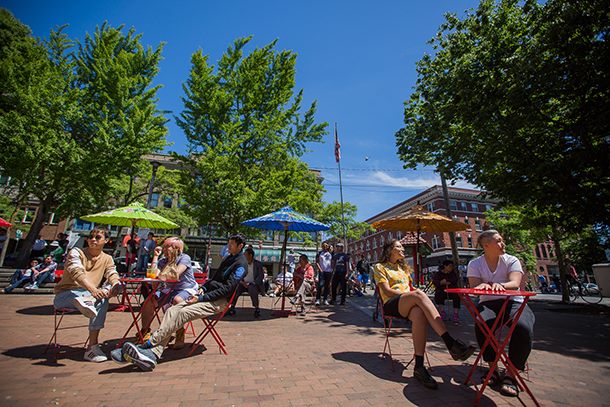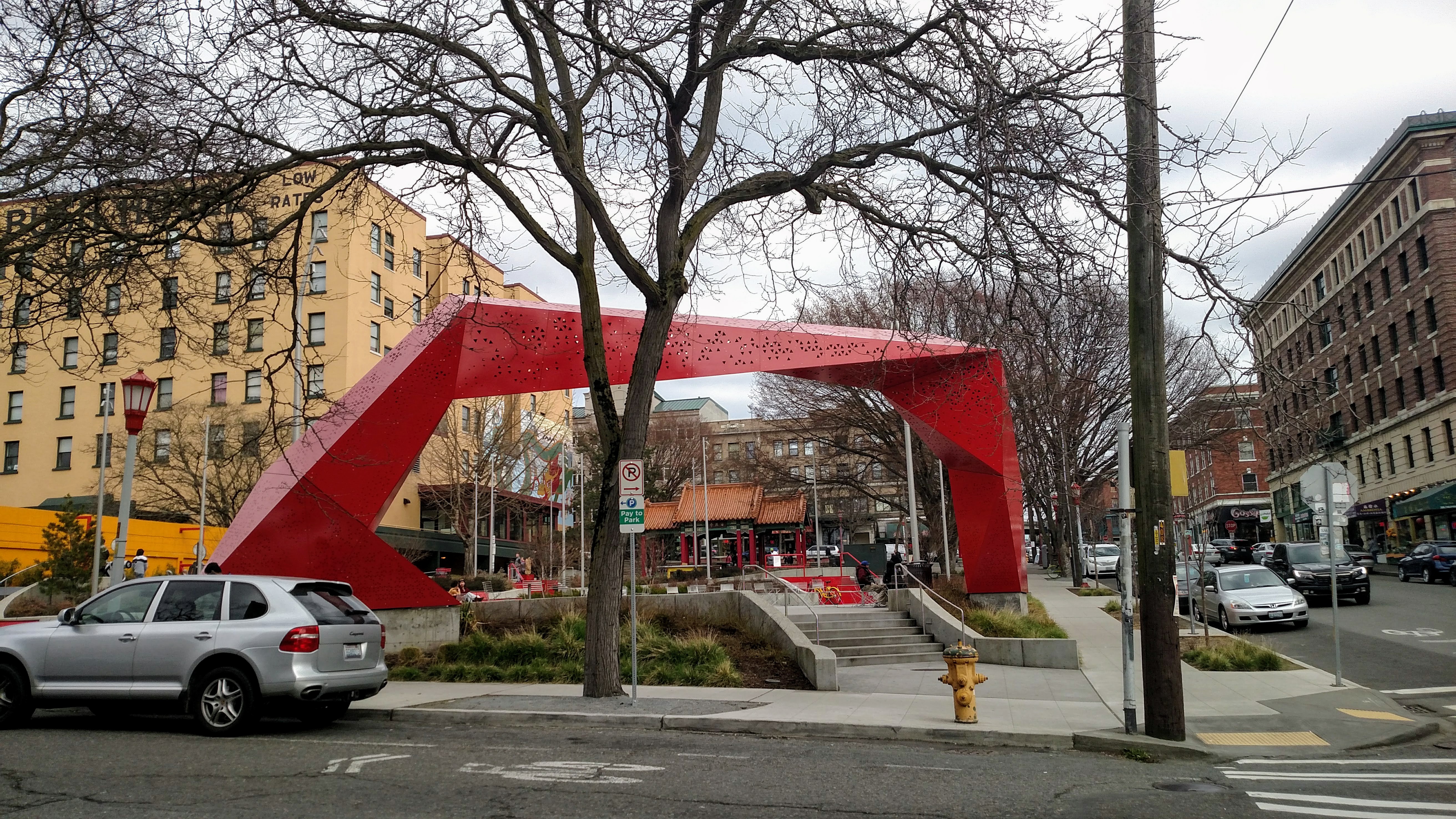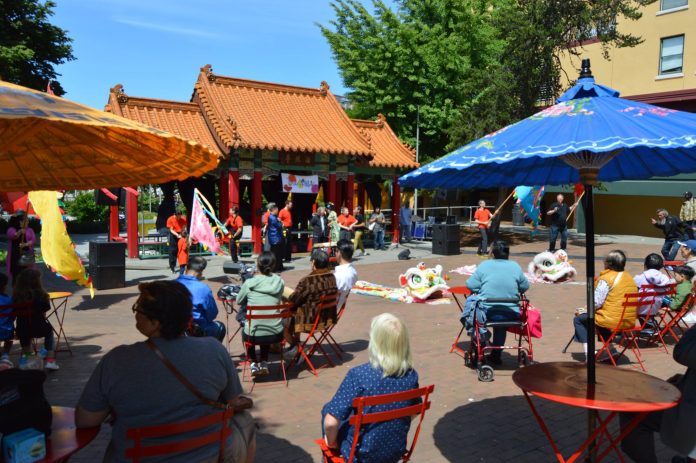This July a packed events schedule in the Chinatown/International District provides extra incentive to become better acquainted with this historic neighborhood’s evolving streetscape. Home to numerous small businesses and unique cultural and historic landmarks, the CID is one of Seattle’s most invigorating neighborhoods to explore on foot.
“The neighborhood is designed in such a way that it doesn’t lend itself to vehicle transportation,” says Mei Yook Woo, who leads walking tours of the CID, most recently for the University of Washington Doris Duke Conservation Scholars Program. “Most of the people who live in the neighborhood are elders who don’t own cars. By coming to the neighborhood as a pedestrian, you help create a safer environment for them.”
There are also many layers of history and culture that are possible to soak in as a pedestrian that you cannot experience in a car. “When you are in the neighborhood you get to enjoy and take in the people who make up the neighborhood,” says Woo. “You get to enjoy the different languages, like Cantonese and Vietnamese, being spoken. And as a pedestrian you can notice cool design features, like the street signage, which is translated into different languages and identifies micro-neighborhoods. Along with old signage, public art, and murals, they are intentional markers that you can identify at a slower place.”
Fortunately, the CID, with its proximity to light rail, buses, and the First Hill streetcar, is extremely accessible to travelers seeking to enter the neighborhood without cars. So this summer, hop onto your nearest public transit option and come out to enjoy the vibrant history and culture of this iconic Seattle neighborhood.
Dragon Fest in Hing Hay Park is July 14th and 15th
Last March the City of Seattle completed its renovation of of Hing Hay Park, which doubled the park’s size. The expanded park features a new performance space, landscaped terraces with integrated seating and flexible micro-stages, ping pong tables, shade trees, and lighting. Sidewalk and utility improvements were made to ensure that the entire park is ADA accessible.

Already the strong turnout for events such as Pride Asia on May 27th has exemplified how well-designed civic parks foster community involvement, inclusivity, and celebration.
The final piece is the completion of a sign for the park. The City has commissioned artist and designer George Lee to “create a beautiful, contemporary sign for Hing Hay Park that is both a functional landmark and piece of place specific art.”
A community meeting was held on July 19th to gather input on design concepts; however, it is not too late to share you opinion through an online survey.

According to the City’s website, Hing Hay Park means “Park for Pleasurable Gatherings.” The year’s biggest gathering, Dragon Fest, will occur on July 14th and 15th, bringing together community organizations and local businesses in the Northwest’s largest celebration of API American heritage.
According to the event website, over 14 hours of nonstop cultural performances are planned, including dragon and lion dances, Taiko drumming, martial arts demonstrations, Bhangra/Bollywood dance, and more. A $3 food walk will give attendees the chance to sample dishes from over 40 participating restaurants and walk off the extra calories as they explore other small businesses participating the festival.
Canton Alley and Nihonmachi Alley
Alleys were an important part of cultural and urban fabric that knit together the CID’s Chinese and Japanese immigrant communities. Exciting projects have been reactivating alleys and installing signage that provides historical context for these importance of these too long neglected urban spaces.
The Canton Alley project was completed in June 2017. According to NW Asian Weekly, “The Chinatown International District Preservation and Development Authority (SCIDpda) and the Chinatown Historic Alley Partnership (CHAP) has worked for the Alley reactivation project for five years. The community’s long-term goal is to bring business back into the vacant storefronts to help draw more foot traffic.”
Part of the Japanese American Remembrance Trail, Nihonmachi Alley provides insight into Seattle’s once thriving Japantown community. The Wing Luke Museum offers an online walking tour in English and Japanese that highlights 42 sites. Guided educational tours offered by the museum focus on the history of the Nihonmachi Alley, and the accompanying Chiyo’s Garden, providing details on life in Japantown, which was the second largest Japanese community on the West Coast until it was uprooted by forced detention of Japanese-Americans during World War II.
On July 19th the Wing Luke Museum will activate Canton Alley and Nihonmachi Alley with JamFest a live music event staged in historic Canton Alley and Nihonmachi Alley. The event is headlined by Julz Ilang-Bulan.
In addition to preserving history, alley activation is a key component of creating safer, denser, more vibrant cities. Last summer, The Urbanist published a post on alley activation. Readers who want to dig deeper into this topic should check out NACTO’s “Seattle Integrated Alley Book: Activating Alleys for a Lively City.”
Danny Woo Community Garden
Just up the hill lies Danny Woo Community Garden, which will host its 43rd Annual Potluck and Pig Roast on July 20th and 21st. Tucked into a hillside adjacent to I-5, Danny Woo Garden is one of the oldest community gardens in Seattle. It is also “the largest green space in the Chinatown/International District and Little Saigon area” and as such “[it] is an essential place for the surrounding community to engage with nature, access safe and healthy food, and build cohesion with neighbors.” At 1.5 acres and containing nearly 100 plots, the garden is also an important source of fresh produce for the primarily elderly Asian residents of the neighborhood. Additionally, the garden features a children’s garden, chicken coop, outdoor kitchen, and fruit tree orchard. It is named in honor of Danny Woo, the landowner who agreed to let the lease the land for a community garden for $1 per year.
The Potluck and Pig Roast will be a great time to celebrate great food and community. Participants should make time to wander the garden’s green terraced paths and admire the gardeners’ careful stewardship of the land.
Activating Alleys: Canton, U District, And Pioneer Square Edition
Natalie Bicknell Argerious (she/her) is a reporter and podcast host at The Urbanist. She previously served as managing editor. A passionate urban explorer since childhood, she loves learning how to make cities more inclusive, vibrant, and environmentally resilient. You can often find her wandering around Seattle's Central District and Capitol Hill with her dogs and cat. Email her at natalie [at] theurbanist [dot] org.


